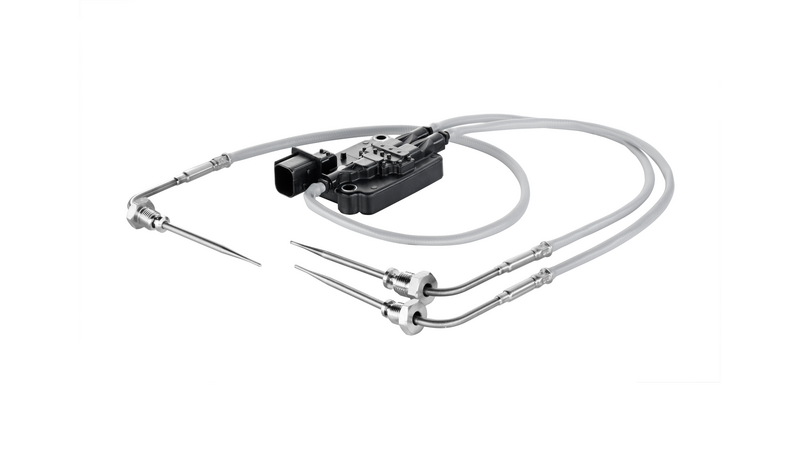Continental Sensors Lower Engine Emissions
- Continental brings its latest innovations in exhaust gas sensor technology to the Chinese market to lower vehicle emissions.
- Both, the high temperature sensor (HTS) and the differential pressure sensor (DPS) provide data for closer control of emission-relevant exhaust gas after-treatment.
- Strong local R&D and technical support in China
Shanghai (China), Regensburg (Germany), Jan 30, 2018. Making modern direct injection (DI) combustion engines comply with stringent emissions legislation, requires a high level of exhaust gas after-treatment: Converting Nitrogen Oxides (NOx) to harmless substances and filtering gasoline and diesel Particulate Matter (PM) out of the exhaust gas flow is therefore a core vehicle function. The technology company Continental recently introduced advanced sensor solutions which serve to further increase the level of control and thus the efficiency of exhaust gas after-treatment to meet motor vehicle emission standards in China and throughout the world. Continental’s smart High Temperature Sensor (HTS) and Differential Pressure Sensor (DPS) are designed to offer fast response and high accuracy measurement when installed in after-treatment systems. The smart HTS sensor is in its 2nd generation now and helps customers to save on system cost and effort.
“The after-treatment market is a promising market worldwide, but we see a particularly strong demand in China. To serve this demand, Continental is constantly developing various technologies to lower emission levels,” says Mr. Fan Mingxiang, Sales Director of the Sensors & Actuators Business Unit China. “We are proud to introduce our 2nd generation High Temperature Sensor and the Differential Pressure Sensor to the Chinese market, and to help our customer to reliably and effectively meet the emissions standards.”
Smart High Temperature Sensor (HTS)
At present the established method to clean diesel exhaust gases comprises a DPF (Diesel Particulate Filter), a DOC (Diesel Oxidation Catalyst), and a SCR (Selective Catalytic Reduction) unit to convert NOx. The complex after-treatment processes are monitored to ensure the maximum conversion and filtering efficiency at all times.
The DI gasoline engine also benefits from the use of a particulate filter, called the Gasoline Particulate Filter (GPF). Sensors provide the key data for this control over emissions. Continental’s smart high temperature sensor can be used in different positions to detect the temperature in the exhaust gas system. This is critical to success because the after-treatment will only work at the right temperature level. To ensure optimum control over emission, the temperature acquisition needs to be fast and accurate. The 2nd generation Continental HTS is tailored to meet these targets. It is based on thermocouple technology which transforms the temperature into an accurate digital signal and forwards it to the Engine Control Unit (ECU) to achieve the optimal catalytic conversion process and On Board Diagnostic. Besides providing crucial data, the HTS can also simplify the system layout with multiple sensor probes for close monitoring. In addition HTS is used for overheating protection of key components such as the turbocharger. Starting from 2016, Continental started to produce the 2nd generation of high temperature sensor in China, Changchun.
Differential Pressure Sensor (DPS)
The Gasoline Direct Injection (GDI) engine possess good fuel economy and can effectively reduce CO2 emission. However, the emission of particulate matter (PM) mass and quantity of a GDI engine is significantly higher than that of a Port Fuel Injection gasoline engine. The GPF and the DPF are designed to remove particulate matter or soot from the exhaust gas of a gasoline/diesel engine. Continental’s Differential Pressure Sensor (DPS) can be used to infer the exhaust gas flow through the GPF/DPF by measuring the differential pressure across the filter. The technology will provide an analog or digital output voltage proportional to the differential pressure across the filter. At a predefined pressure delta the ECU will initiate a regenerative process to burn-off the PM accumulated in the filter, restoring its flow.
“Continental’s Sensors & Actuators team has a strong capacity for both products in terms of production and R&D. I am confident that the local team will give complementary and dedicated service to the local customers”, Mr. Fan Mingxiang added.

Simone Geldhäuser
Head of Media Relations & Press Spokesperson Innovation & Technology
Vitesco Technologies
- +49 941 790-9961302
Tina Chen
Head of Communications China
- +86 21 6080 3263

